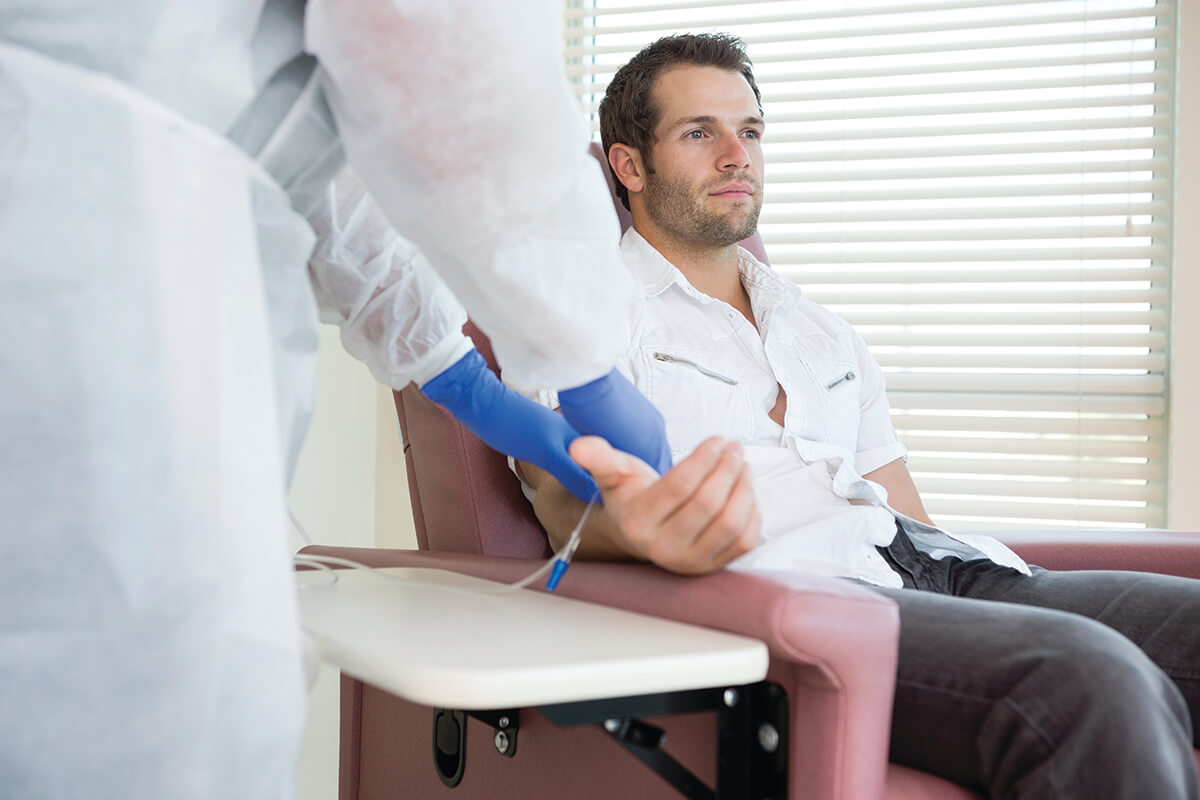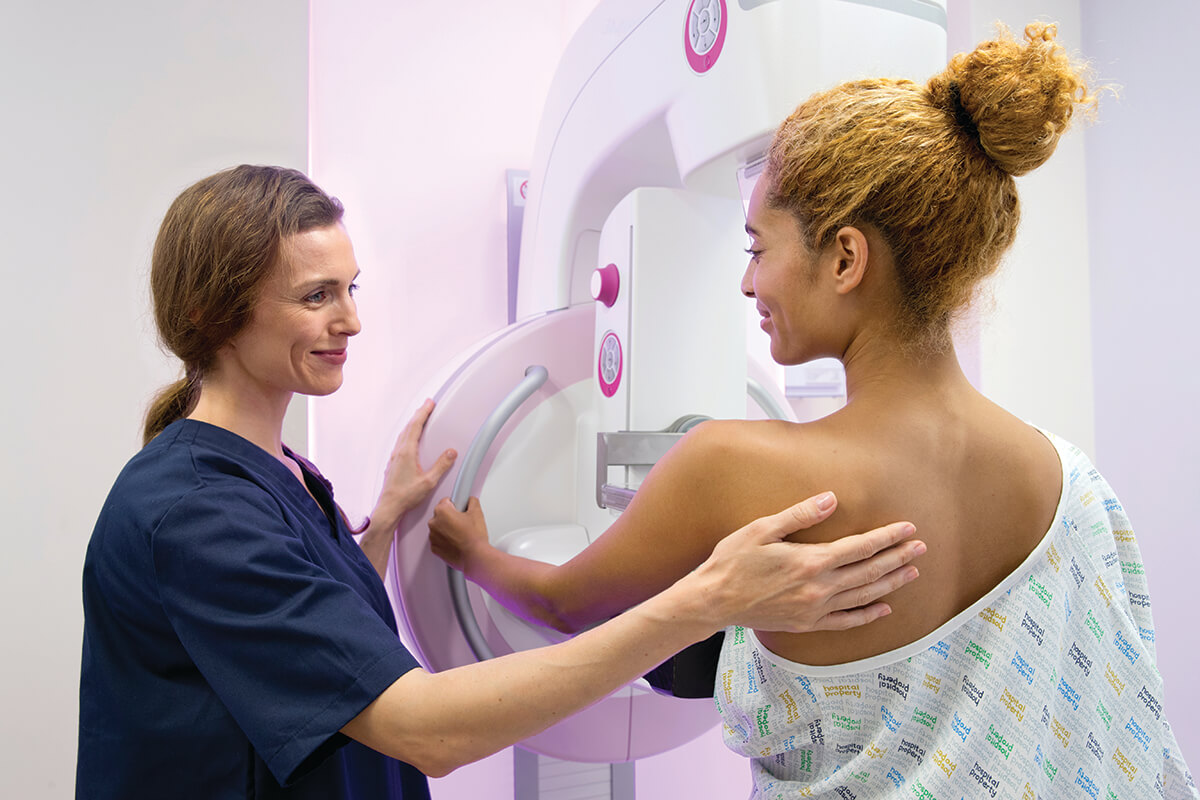Special Section
Doctors Orders: Shooting for the Moon
Significant advances in cancer treatment are bringing us ever closer to ending the disease.
By Abigail Green — July 2023
 n April, the U.S. Department of Health and Human Services released a National Cancer Plan, the next step in achieving the ambitious goal set by President Joe Biden and first lady Jill Biden’s Cancer Moonshot: ending cancer as we know it.
n April, the U.S. Department of Health and Human Services released a National Cancer Plan, the next step in achieving the ambitious goal set by President Joe Biden and first lady Jill Biden’s Cancer Moonshot: ending cancer as we know it.
Developed by the National Cancer Institute (NCI), the plan lays out goals and strategies to prevent cancer, reduce deaths from cancer, and ensure the best quality of life for people living with cancer.
“The National Cancer Plan is a vision and a road map for how we can make faster progress against this all-too-common disease,” said NCI Director Monica M. Bertagnolli, M.D., in a press release. “By working together, we can achieve the Cancer Moonshot goal of reducing the cancer death rate by 50 percent within 25 years.”
Thanks to leaders in cancer research and clinical care in Maryland, we are well on our way toward that goal. Baltimore is home to two of the NCI-designated comprehensive cancer centers in the United States: Sidney Kimmel Comprehensive Cancer Center at Johns Hopkins University, and University of Maryland Marlene and Stewart Greenebaum Comprehensive Cancer Center. Together with other top hospitals in the area, including Mercy Medical Center and LifeBridge Health, they are leading the charge to end cancer and save lives. We spoke to doctors on the front
lines of the fight against cancer about the most exciting advances in their specialties.

DR. WILLIAM NELSON
Director of the Sidney Kimmel Comprehensive Cancer Center at Johns Hopkins Hospital
Since the peak year for cancer mortality in the United States in 1991, there has been a nearly 30 percent drop in the overall cancer death rate, translating to approximately 2.6 million fewer cancer deaths, notes Nelson, who specializes in the treatment and research of prostate cancer. “That’s been really impressive.” This decline in cancer deaths over the past few decades is largely the result of reductions in smoking and advances in early detection and treatment, in particular for the four major cancers: lung, breast, colorectal, and prostate. Nelson held the patent for one of the first diagnostic tests for prostate cancer approved by the FDA.
Today, he says one of the most significant discoveries that has revolutionized cancer medicine are DNA detection technologies. If you can take one hair follicle from a crime scene and do a DNA analysis and convict a murderer, can’t you use the same kinds of technologies to detect one cancer cell in the wrong place at the wrong time? “The answer to that is going to end up being ‘yes,’” says Nelson.
Many cancers shed DNA (often called circulating tumor DNA or ctDNA) into the bloodstream, he explains. A blood test can detect ctDNA, which makes it a promising tool for cancer diagnosis and monitoring, as well as for guiding cancer treatment. Currently, blood ctDNA tests can be given to patients who already have cancer to study their response to treatment or to identify new gene defects that could lead to a treatment change. In the future, a blood test given to a healthy person could screen for ctDNA and detect cancers (or cancer precursors) at a very early stage. It can also be used after treatment to see if it worked.
While more studies are needed and are, in fact, currently underway, ctDNA technology also will drive more personalized cancer treatment. By analyzing the genetic mutations in the ctDNA, doctors can identify the specific mutations causing the cancer’s growth and choose targeted therapies that are most likely to be effective.

DR. MAITRI KALRA
Director of Breast Medical Oncology, LifeBridge Health
“When we talk about breast cancer, it’s not one disease. It’s different types of cancer that happen to originate in the breasts,” says Kalra. There are three main categories of breast cancer: hormone-positive breast cancer, HER2-positive breast cancer, and triple-negative breast cancer. This last category is “essentially a diagnosis of exclusion,” she explains, meaning that not much is known about the specifics of the disease, other than that it doesn’t fall into one of the other two categories. Patients with triple-negative breast cancer have typically been treated with chemotherapy.
Historically, about 15-20 percent of metastatic or Stage 4 breast cancers were HER2-positive, while the rest were HER2-negative, says Kalra. Now, doctors have identified a new category called HER2 low breast cancer, which responds very well to a new drug.
“That’s a big discovery that’s changed the paradigm of how we treat Stage 4 breast cancer. It offers a new option for these metastatic triplenegative breast cancer patients to get a more targeted treatment,” she says. This means that about half of metastatic breast cancer patients (the predicted number who will be identified as HER2 low) who previously had no other option besides chemotherapy will now have access to this new treatment, part of a class of drug called antibody-drug conjugates (ADCs).
Kalra calls this “the next significant discovery in breast cancer in the last few years.” She describes an ADC as a “Trojan horse” that carries chemotherapy particles inside an antibody molecule. The ADC targets cancer cells directly and more effectively, with fewer side effects
compared to chemotherapy.
There are other types of ADCs that have either been approved or are in development for other breast cancers, including earlier stage breast cancers. “In the future, this may replace chemotherapy entirely in breast cancer treatment,” says Kalra.
She adds that another recent advancement in early-stage breast cancer is the addition of immunotherapy. This is a type of treatment that harnesses the power of the body’s own immune system to fight diseases while preserving healthy cells. “In the breast cancer world that’s huge, because we have been using immunotherapy for five-plus years in lung cancer, melanoma, and other cancers. But finally, it is now an option of treatment for patients with early-stage triple-negative breast cancer.”

DR. VADIM GUSHCHIN
Director, HIPEC Program at Mercy Medical Center
Patients with advanced abdominal cancer from all over the country and the world come to Mercy Medical Center for a life-saving procedure known as hyperthermic intraperitoneal chemotherapy (HIPEC). Now, doctors at the Institute for Cancer Care at Mercy are trying to pioneer the use of this treatment for ovarian cancer.
The two-part procedure starts with an aggressive surgery to remove tumors, called cytoreductive surgery. This may require the removal of organs, depending on how much the cancer has spread. Next, a heated chemotherapy wash is administered inside the abdominal cavity to kill any remaining microscopic cancer cells. The entire HIPEC procedure can take 6-12 hours to complete. Gushchin describes it as “a grueling treatment.”
However, HIPEC patients are traditionally those with Stage 4 cancers who don’t have any other treatment options. “These patients are told, ‘There’s nothing we can do’,” says Gushchin.
HIPEC was pioneered in the 1980s by a Baltimore-born physician named Dr. Paul Sugarbaker, yet it took 20 years for his procedure to become widely accepted in surgical oncology, says Gushchin. “It used to be very marginalized, and nobody thought it could be done seriously on a large scale.”
Now, Gushchin and his colleagues are facing the same resistance as they try to prove that HIPEC can improve treatment and outcomes in ovarian cancer patients. The deadliest of all gynecological cancers, advanced ovarian cancer has only about a 50 percent five-year survival rate. “HIPEC could be a game-changer in the optimal management of women with ovarian cancer and peritoneal metastasis, provided further, well-designed studies prove so,” stated a 2021 article published in the medical journal Cureus.
That’s exactly what Gushchin and his colleagues, including Dr. Teresa Diaz-Montes, are attempting to do by conducting one of the first clinical studies in the United States regarding treatment of ovarian cancer with HIPEC. They presented their initial findings at the annual Society of Gynecologic Oncology meeting in March 2023.
One of the concerns from the gynecological community is that HIPEC is a very difficult treatment for ovarian cancer patients to tolerate and recover from, and that their quality of life suffers, says Gushchin. “It was on us to prove that patients go back to normal life or even better. And that’s what we found.” The study showed that patients return to pre-treatment quality of life six months after surgery, and after one year they exceed it. Some studies show HIPEC also improved survival rates in ovarian cancer patients by as much as two years, though Gushchin notes that survival rate was not the primary end point of the Mercy study and further research is needed.
One thing that Gushchin particularly values in his work is the collaboration between surgical oncologists and gynecological oncologists.
This partnership is still fairly uncommon in the U.S., he says, but enhances each specialty’s performance as well as patient outcomes. “This collaboration is critical to treat women the best way possible.”

DR. AARON RAPOPORT
Director of the Transplant and Cellular Therapy Program at the University of Maryland Greenebaum Comprehensive Cancer Center
Rapoport, a hematology specialist with more than 30 years experience treating patients for blood cancers including lymphoma, myeloma, and leukemia, specializes in some of the most advanced and effective methods for blood cancer treatment.
One of the newest and most exciting treatments is known as CAR T-cell therapy. The Greenebaum Comprehensive Cancer Center was the first center in Maryland, Delaware, and Virginia to be qualified to perform CAR T-cell therapy. It works like this: A type of immune cells called T-cells are collected from a patient.
Then these cells are genetically engineered in a lab to express a new, totally synthetic protein on the cell surface called a CAR, which stands for “chimeric antigen receptor,” explains Rapoport. He calls this genetically modified cell “a freak of nature—it has an antibody on the outside and T-cell signaling domains on the inside.” The CAR T-cells are infused back into the patient, where they proliferate and expand and become very activated. “They are able to recognize and attach to cancer cells and deliver killing molecules to the cancer cell,” he says. One of his mentors dubbed them “serial killers.”
Typically, patients who qualify for CAR T-cell therapy have limited treatment options. CAR T-cell therapy can cure acute leukemia in children and young adults as well as aggressive B-cell lymphoma, the most common type of lymphoma. “CAR T-cell therapy is also approved and effective for treating patients with advanced and refractory multiple myeloma,” he also says.
“There is a lot of research and promise for CAR T-cell to be effective with other cancers as well,” says Rapoport. He and his colleagues at the University of Maryland are involved in a number of clinical trials related to lung, gastrointestinal, and gynecological cancers, and in their lab, they are working on developing next-generation CAR T-cell therapies for blood cancers and certain solid tumor therapies.
To date, the Greenebaum Comprehensive Cancer Center has treated more than 300 patients from many different states. “More than half the patients we’ve treated are alive because of CAR T-cell therapy,” says Rapoport.

